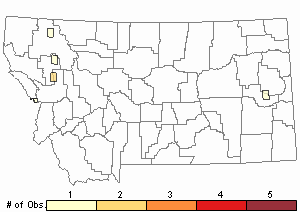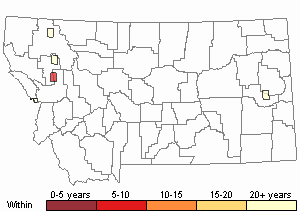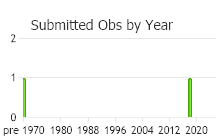View in other NatureServe Network Field Guides
NatureServe
Montana
Utah
Wyoming
Idaho
Wisconsin
British Columbia
South Carolina
Yukon
California
New York
A Torncap Moss - Bucklandiella microcarpa
Other Names:
Racomitrium microcarpon, Racomitrium heterostichum var. microcarpon
General Description
Plants: Growing in open to crowded clumps of upright shoots or tangled mats, green, pale yellow, occasionally tinged with grey or white above and appearing hoary, brown to black below. Stems mostly 2-4 cm in length, but occasionally up to 7, creeping to nearly upright, profusely laterally branched, many of the branches so short as to look like knobs (FNA 2007).
Leaves: Somewhat erect, overlapping, and frequently curved toward one side when dry, spreading a little when wet, 1.5-3.8 mm in length and 0.4-0.8 mm in width, lance-shaped, folded longitudinally above with a slender groove below; apex with a hair-point or rarely without, the hair-point hyaline, mostly 0.3-0.7 mm in length (sometimes longer) (FNA 2007), toothed, not papillose (Smith 1980); margins curved back and down for half or more the length of the leaf, seldom to the leaf tip; costa extending to the leaf tip, the dorsal surface rounded (FNA 2007).
Leaf Cells: Laminal cells smooth or frequently appearing papillose from longitudinal cuticular hills, unistratose; middle and upper cells oblong and very wavy, becoming wider than long toward the leaf edges; basal laminal cells long and narrow to linear, with thick, pitted walls; alar cells only slightly distinguished, if at all; margins of 1 cell layer, occasionally regions of 2 layers; basal marginal cells along the base in two rows, the cells square to short-oblong (seldom long), rarely wavy, seldom green with chlorophyll; costa in X-section from 2-3 cell-layers thick proximally, 2 cell-layers thick near the apex, and with 2-5 relatively large dorsal cells proximally transitioning to 1-3 dorsal cells near the apex (FNA 2007).
Diagnostic Characteristics
R. microcarpon differs from Racomitrium affine, R. heterostichum, and R. sudeticum in having well-developed basal borders (running up the leaf sides from the base), the cells of which are pellucid and not wavy. The other species do not have basal marginal borders or they are not well-defined (FNA 2007).
Range Comments
North American Range
More common in the east, occurring infrequently and mostly in the Rocky Mountains in the west. AK to WA, MT, MN, QC to NL and NS, NY ne to NB (FNA 2007). Known in Montana from Lake County (Elliott 2016).
Observations in Montana Natural Heritage Program Database
Number of Observations: 6
(Click on the following maps and charts to see full sized version)
Map Help and Descriptions
Relative Density

Recency



 (Observations spanning multiple months or years are excluded from time charts)
(Observations spanning multiple months or years are excluded from time charts)
Habitat
Acidophilic, mostly in moist to dry, open habitats; on large stones and bluffs, soil, areas of lingering snow, rocky inclines, granite (FNA 2007).
Reproductive Characteristics
Dioicous. Inner perichaetial leaves prominently differentiated, hyaline below, green (chlorophyllous) above, seldom with a hair-point (FNA 2007).
Seta 2.5-8 mm tall, somewhat russet. Capsule mostly 1.2-2 mm in length, 0.3-0.6 mm in width, brown, a little shiny or not, exserted; operculum with a straight or oblique beak; peristome dentitions split almost to the base into 2 lobes or else long and narrowly perforate; somewhat red with yellow tones, papillate (FNA 2007).
Stewardship Responsibility
References
- Literature Cited AboveLegend:
 View Online Publication
View Online Publication Elliott, J.C. and A.K. Pipp. 2018. A Checklist of Montana Mosses (1880-2018). Updated 3 January, 2020. Montana Natural Heritage Program, Helena, Montana. 73 pp.
Elliott, J.C. and A.K. Pipp. 2018. A Checklist of Montana Mosses (1880-2018). Updated 3 January, 2020. Montana Natural Heritage Program, Helena, Montana. 73 pp. Flora of North America Editorial Committee, eds. 2007. Flora of North America North of Mexico. Volume 27. Bryophytes: Mosses, Part 1. Oxford University Press, Inc., NY. xxi + 713 pp.
Flora of North America Editorial Committee, eds. 2007. Flora of North America North of Mexico. Volume 27. Bryophytes: Mosses, Part 1. Oxford University Press, Inc., NY. xxi + 713 pp. Smith, A.J.E. 1980. The Moss Flora of Britain and Ireland. Cambridge University Press, Cambridge. 705 pp.
Smith, A.J.E. 1980. The Moss Flora of Britain and Ireland. Cambridge University Press, Cambridge. 705 pp.
- Additional ReferencesLegend:
 View Online Publication
View Online Publication
Do you know of a citation we're missing? Crum, H.A. and L.E. Anderson. 1981. Mosses of Eastern North America. 2 volumes. Columbia University Press, New York. 1328 pp.
Crum, H.A. and L.E. Anderson. 1981. Mosses of Eastern North America. 2 volumes. Columbia University Press, New York. 1328 pp. Elliot, J. C. 1993. Second checklist of Montana mosses. Unpublished report. U.S. Forest Service, Region 1. Missoula, MT. 45 pp.
Elliot, J. C. 1993. Second checklist of Montana mosses. Unpublished report. U.S. Forest Service, Region 1. Missoula, MT. 45 pp. Lawton, E. 1971. Keys for the Identification of the Mosses on the Pacific Northwest. Reprinted from 'Moss Flora of the Pacific Northwest'. Published as Supplement No. 2 of the Journal of the Hattori Botanical Laboratory. Nichinan, Miyazaki, Japan. 66 pp.
Lawton, E. 1971. Keys for the Identification of the Mosses on the Pacific Northwest. Reprinted from 'Moss Flora of the Pacific Northwest'. Published as Supplement No. 2 of the Journal of the Hattori Botanical Laboratory. Nichinan, Miyazaki, Japan. 66 pp. Lawton, E. 1971. Moss Flora of the Pacific Northwest. Hattori Botanical Laboratory. Japan: Yamabuki-cho, Shinjuku-ku, Tokyo. 362 pages plus appendices.
Lawton, E. 1971. Moss Flora of the Pacific Northwest. Hattori Botanical Laboratory. Japan: Yamabuki-cho, Shinjuku-ku, Tokyo. 362 pages plus appendices. Malcolm, B., N. Malcolm, J. Shevock, and D. Norris. 2009. California Mosses. Nelson, New Zealand: Micro-Optics Press. 430 pp.
Malcolm, B., N. Malcolm, J. Shevock, and D. Norris. 2009. California Mosses. Nelson, New Zealand: Micro-Optics Press. 430 pp. Vitt, D. J. Marsh, and R. Bovey. 1988. Mosses, Lichens & Ferns of Northwest North America. Seattle, WA: University of Washington Press. 296 p.
Vitt, D. J. Marsh, and R. Bovey. 1988. Mosses, Lichens & Ferns of Northwest North America. Seattle, WA: University of Washington Press. 296 p.
- Web Search Engines for Articles on "A Torncap Moss"





